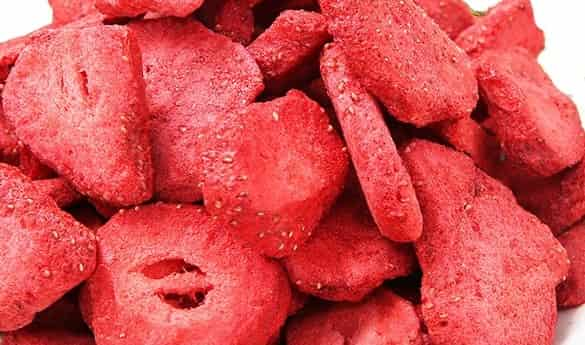Freeze-dried fruits have become a regular item in our freezers and daily diet. As noted, their popularity has increased recently due to a growing push for healthier snacking. The juicing and smoothie trends have also boosted the consumption of freeze-dried fruits. Usually, people blend these fruits with fresh ingredients to make healthy homemade smoothies and juices. Sometimes, people add freeze-dried fruits to improve the flavor profile of, for instance, green smoothies. Despite their growing use, some consumers often question whether freeze-dried fruits are healthy.
What Does Freeze-Drying Really Mean?
Freeze-drying (also lyophilization) is a form of preservation that involves eliminating up to 99% water from food at low temperatures and pressure. The sublimation process helps convert ice into a gas without first melting it into a liquid. Thus, freezing-drying is a more gentle approach to dehydration. It is better than conventional dehydration that entails heating foods to evaporate their water. Freeze-drying also yields a high-quality product and helps preserve food color and flavor. Rehydration usually helps reconstitute a fruit to its original form, making freeze drying one of the best preservation methods.

Here is Why Freeze-Dried Fruits are a Healthier and Better Option?
Freeze-drying produces fruits of superior quality. It is generally better than other dehydration methods, given that it preserves taste, aroma, color, bioactivity, and the original appearance. Freeze-dried fruits also rehydrate fully and quickly by simply soaking in water. One must allow adequate time for the fruits to reconstitute fully for the best results.
Freeze-dried fruits have a nutrient profile almost equivalent to that of fresh fruits. Evidence suggests that freeze-drying helps retain most vitamins, antioxidants, and minerals. Freeze-dried fruits usually lose a significant amount of vitamin C because it is water-soluble. Therefore, it destabilizes with freeze-drying resulting in notable losses.
Even so, this process is still better in preserving vitamin C when compared to oven-drying and other dehydration methods. It does not expose heat-sensitive and volatile nutrients to thermal damage, helping keep them intact. Thus, freeze-dried fruits preserve nearly all nutritional components, including volatile compounds.
In addition, freeze-dried fruits retain their texture and their original shape. They also have a better rehydration potential than air-dried fruits. They can rehydrate fully within a short period and maintain a mouth feel equal to that of fresh fruit. The taste and texture are also superior to those of frozen fruits. As noted, freezing foods in a refrigerator causes ice crystals to form in intercellular spaces and cells. These ice crystals often damage the cell wall and membrane, negatively affecting the food microstructure and its quality. As a result, frozen fruits become mushy, which is not the case for freeze-dried fruits.
Is Freeze-Dried Fruit Better Than Fresh Fruit?

People often ask whether freeze-dried fruit is better than fresh fruit. The answer is not straightforward because each has its benefits and disadvantages. As noted, the nutrient content of freeze-dried and fresh fruits varies slightly, given that the former experiences a decrease in specific nutrients such as vitamin C.
However, freeze-dried fruits may still have a higher nutrient content because harvesting and freeze-drying happen at the ideal time. Usually, this process occurs when a fruit has reached peak ripeness. At this time, it has the highest nutrient concentration. Fresh fruits may also not always have the highest nutrient content because their quality and nutritive value deteriorate rapidly over time.
The choice between freeze-dried and fresh fruits also depends on the situation and use. For instance, one may choose freeze-dried fruits when there is limited availability of fresh fruits in the off-season. Freeze-dried fruits also serve as a better and more convenient choice when making smoothies and juices.
Freeze-dried fruits also have a higher sugar concentration than fresh fruits. It follows that freeze-drying eliminates water and shrinks fruit size, making the sugar more concentrated. Therefore, taking a lot of freeze-dried fruits as a snack in a single sitting will mean you will consume more sugar than when eating fresh fruits. It is necessary to watch the portions with freeze-dried fruits. Pairing these fruits with foods containing proteins, polyunsaturated fats, and monounsaturated fats can also help. It ensures the snack is well-balanced.
The Amazing Benefits of Freeze-Dried Fruits
They add convenience
Freeze-dried fruits come with a lot of conveniences. Usually, they provide an easily-to-carry and healthy snack. They also reduce the hassle of preparing fresh fruit for juices or smoothies. In addition, one can consume the fruits as a crisp snack or rehydrate them. Freeze-drying also ensures easy access to off-season fruits and their use in daily meals. Freeze-dried fruits also save a lot of space in the freezer compared to fresh and frozen fruits.
They have a long shelf-life
Freeze-drying removes nearly all water in a food. As a result, this increases the shelf-life of the fruits. This process also curbs against reactions that cause deterioration. In particular, it halts or slows down these reactions ensuring the fruits stay longer without going bad. These factors, coupled with proper packaging and good storage, guarantee a shelf-life of up to 25 years. The quality of the packaging container significantly influences the shelf-life. For instance, Mylar bags or cans facilitate storage for 25 years or more. By contrast, freeze-dried fruits in polybags last between six months to three years.
They have natural sensory qualities
Usually, freeze-dried fruits retain the natural flavor, aroma, color, and texture. This characteristic makes them a quality snack and one of the best preserved products in the market. The flavor profile also does not change. These fruits maintain the same taste and aroma as fresh fruits. Thus, they are a visually appealing and healthy option.
They have an excellent nutrient profile
Generally, freeze-dried fruits preserve a lot of their original nutrients. If any loss occurs, it is minimal. A substantial amount of vitamin C gets lost with freeze-drying. However, freeze-drying increases vitamin and mineral content in some cases. For instance, freeze-dried apricots have more iron content than fresh fruits. It means that eating a small portion of these fruits provides more iron and can help satisfy the recommended daily intake with ease.
Freeze-dried fruits also supply adequate amounts of antioxidants and fiber. For instance, evidence suggests that freeze-drying seabuckthorn berries preserved 93% more carotenoids than hot air drying. The process also retained 11% more phenolic compounds. These antioxidants promote good health by eradicating free radicals and reducing disease risk. On this note, freeze-drying is a better dehydration method.
They have no preservatives
Generally, the low moisture conditions of freeze-dried fruits play a critical role in preventing microbial growth and contamination. In addition, vacuum sealing helps keep oxygen and moisture out. It protects fruits from deterioration and preserves them for a long period. Therefore, freeze-dried fruits do not need preservatives to increase their shelf-life.
The Downsides Of Freeze-Dried Fruits
They are more expensive
The convenience associated with these fruits comes at a high cost. Usually, freeze-dried fruits cost more than those processed using conventional drying. They sometimes cost five times more. On this note, food companies restrict freeze-drying to high-value foods.
They might develop microbial contamination
Although not common, microbial growth can occur in poorly stored or packaged freeze-dried fruits. Usually, the pathogens in a product remain in the freeze-dried item. Therefore, they can survive, multiply, and contaminate freeze-dried fruits with faulty packaging or poor storage.


Well researched. Excellent reading. Thanks